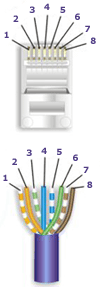How to make a Cat 5 Cable / ethernet / RJ45 / network cable
Cat 5 Cable / ethernet / RJ45 / network cable
Modern homes need cat 5 cable (a.k.a. ethernet cable, network cable or RJ45) running all over the place. Home networks, security cameras, telephones and even HDMI devices—among other products—can use cat 5 to transmit their data. (In my file-transfer tests, wired ethernet over cat 5 is still about 20 times faster than a wireless network.)
When my house was built in 1913, the builders didn’t have the foresight to run cat 5 everywhere. So, last night, I had to run some more, and I realized that even a lot of tech-friendly people don’t know how easy it is to make your own cat 5 cables. If you’re going to run a lot of cat 5, making your own is about a tenth of the cost of buying pre-crimped cables. And, it only takes a minute or two for each cable.
This article shows you how to get the few pieces of equipment you’ll need, and breaks it down into a simple three-step process.
Advantages: Cost and flexbility
Pre-crimped cat 5 cables seem to cost $10 – $15, regardless of length. Yet, you can buy a kit with 500 feet of uncrimped cat 5 cable that includes the crimping tool and 50 cat 5 plugs for about 90 bucks. Assume the average cat 5 cable is 10 feet. That’s enough to make 50 ten-foot cable at a cost of $1.80 per cable. Cable manufacturers can charge an 830% mark-up because most folks don’t realize just how easy it is to make your own cables. (If you buy the cable in bulk once you have the right tools, you could probably drive the marginal cost down to $0.50 per cable.)
But, cost isn’t the only advantage to making your own cables. If you need to thread cat 5 through a tight conduit in your home, it’s much easier to run the cable without the heads attached and the crimp the ends once it’s in place.
Or, if you need to run the cable a very long distance (> 50 ft), it’s often hard to find crimped cables of that length in stores.
Finally, if you’re trying to clean up a closet full of wires, you can avoid the twisty ties by cutting cat 5 cables at just the right length (plus a little slack, of course.)
Supplies
To make your own cat 5 cable, you’ll want:
- A length of bulk, uncrimped cable
:

- A crimp tool
:

- A box of cat 5 plugs
:

Or, you could buy an all-in-one kit that contains everything (plus a line testing tool):

Three-steps: Strip, Arrange, Crimp
After you’ve cut the cable to desired length and run it between two locations, it’s time to attach the plugs. Fortunately, it’s a simple three-step process at each end.
Step 1: Strip
Using the stripping razor on the crimp tool, strip 3-5 millimeters off the sheath at the end of the cable. (Crimp tools have a special razor that cuts the sheath without cutting the internals, but you can use any sharp blade or pair of scissors if you’re careful.)
If you somehow accidentially cut the internal wires, just cut the wire an inch down and try stripping again. (So, leave yourself a few spare inches in case you mess up.)
After you strip, you’ll find 8 color-coded wires inside.
Step 2: Arrange
For making a standard cat 5 cable, you’ll want to arrange the color-coded wires in the same order on both ends. It actually doesn’t matter which order you put the colors in, as long as it’s the same on both ends.
If you want to follow a popular convention use the “568B” ordering. The 568B ordering is:
- White/orange striped.
- Solid orange.
- White/green striped.
- Solid blue.
- White/blue striped.
- Solid green.
- White/brown striped.
- Brown.

Notes
If you’re interested in the details, you technically only need to get 4 of the wires in the same position for 10/100 ethernet. 10/100 uses two internal wires (wire 1 and wire 2) to create a circuit for sending, and two internal wires to create a circuit for receiving (wire 3 and wire 6). It’s still a good idea to use the same ordering on both ends, since ever more devices (like gigabit ethernet, home security cameras or HDMI transceivers) can run over cat 5 lines with each passing year, and these devices expect all of the wires to be in the right place.
(If you want to make a less common “patch” or “cross-over” cable for going directly from computer-to-computer instead of computer-to-router/modem/hub/switch, you’ll need to have a slightly different order on both ends. Actually, you rarely need to make a patch cable these days, since many devices auto-detect which kind of cable is plugged in. If you’re not sure what to do, make the standard cable I describe above.)
Step 3: Crimp
Insert the colored wires into the cat 5 plug. I recommend “scooping” them into the plug, since you probably had to fan them out to put them in the right order. After you’ve scooped them, double check that they stayed in the right order. It may take a scoop or two to get it right.
Once they’re in the right order in the plug, push them flush against the tip.
Then, insert the plug into the crimp tool and squeeze.
Cat 5 plugs contain metal “teeth” that pierce the colored wires during crimping to create electrical conductivity.
Repeat this process for the other end, and you’re done.
Reference





